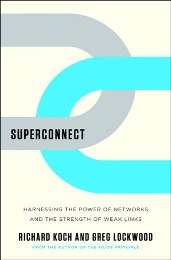
Superconnect: Harnessing the Power of Networks and the Strength of Weak Links
by Richard Koch and Greg Lockwood
–Reviewed by Noelle Loh
 Before there was online social networking, there was plain old networking and the cliches that went along with it – six degrees of separation, it’s a small world. Superconnect, which claims to help readers “discover the laws of our superconnected world,” is littered with these truisms, making it seem like a guide mostly for those who still remain disconnected.
Before there was online social networking, there was plain old networking and the cliches that went along with it – six degrees of separation, it’s a small world. Superconnect, which claims to help readers “discover the laws of our superconnected world,” is littered with these truisms, making it seem like a guide mostly for those who still remain disconnected.
Koch, a management consultant turned business self-help writer, and venture capitalist Lockwood have taken on the tricky task of trying to reinvent the way networks should be perceived and used. Their main proposition: While those in our closest networks – our family members, friends, colleagues – might be the most reliable, collaborating solely with them limits our exposure to opportunities. Instead, we need to think laterally about our social circles and never underestimate the value of that distant acquaintance, that so-called “weak link”. As they write, “Weak links drive the exponential increase in the value of our networks.”
The advice is actually a good reminder of what anybody with a Facebook account-latest reports have the figure hovering at half a billion – often takes for granted. With the advent of such social media tools, whom you barely know, might know, and could know has come to be as relevant as whom you already know. LinkedIn launched as a job-networking site, and Facebook and Twitter are just as useful for finding work, old friends, or long-lost family members. It’s not uncommon for younger users to have, as the authors note, citing business strategist Don Tapscott, around 700 contacts, many of them not well-known (though the average Facebook user has about 130).
In what would appear to be a bold move in light of the economic crisis, the authors even devote a chapter to encouraging job mobility, challenging readers to question when it is time to leave one career or company for another. The answer, they suggest, lies in deciding whether the hubs – the authors’ buzzword for any place where people come together and cooperate – you’re in are good or bad. They define a bad hub as an organization where one feels unfulfilled, uncomfortable, unappreciated or uninspired in. If in doubt, they say simply, leave.
In their enthusiasm to illustrate the power of weak links, Koch and Lockwood pull in a wide range of scientific and sociological theories, classic business models, cultural references as obvious as Google and as potentially blasphemous as Paul the Apostle, and real-life anecdotes – including the too-often-repeated tale of their own meeting – that come across more convenient than convincing.
Excerpt: “… if you’ve been a key part of a fine hub, it will automatically help you later. You get two lives for the price of one: the one you’re living now; and the one you lived before, which continues to deliver significant emotional, social and economic dividends. This sheds new light on effective networking. It’s not a frantic fight to connect superficially with anyone you happen to meet. The lesson I learned accidentally is to select a new hub and work creatively inside it, every few years, to make life even more fulfilling. Work networks in particular build cumulatively – each move creating a new network that we can use for our next upward leap.”
Further reading: Networking for People Who Hate Networking: A Field Guide for Introverts, the Overwhelmed, and the Underconnected by Devora Zack and Connected: The Surprising Power of Our Social Networks and How They Shape Our Lives
by Nicholas A. Christakis and James H. Fowler
Noelle Loh is a freelance journalist who writes about fashion, retail and urban studies.
*Photo courtesy Sascha.




Send A Letter To the Editors